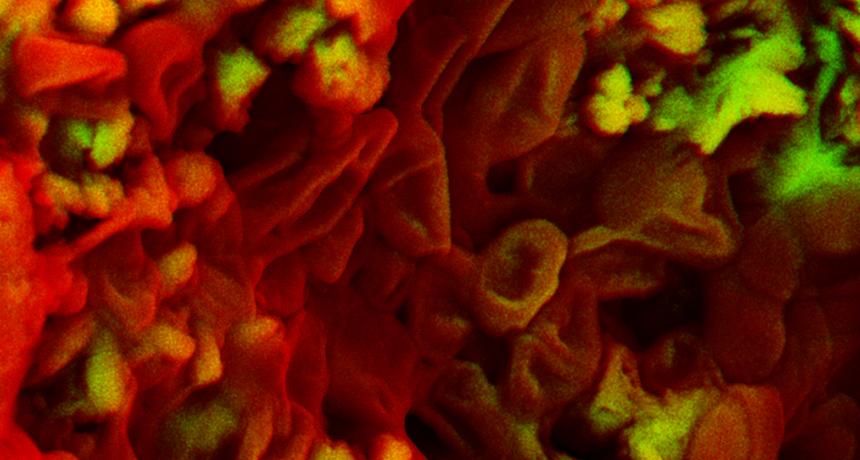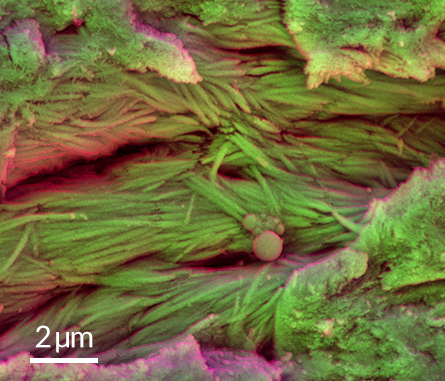More dinosaur bones yield traces of blood, soft tissue
Discovery gives scientists more places to search for clues to when warm-bloodedness emerged

A scanning electron micrograph of a sliver of theropod claw reveals oval-like structures. These resemble red blood cells in living birds. Less dense, carbon-based material appears red. Denser mineralized material appears green.
S. BERTAZZO ET AL/NATURE COMMUNICATIONS 2015
Scientists studying dinosaur evolution are finding many more bones to pick.
Researchers from London have found hints of blood and fibrous tissue in a hodgepodge of 75-million-year-old dinosaur bones. These fossils had been poorly preserved. That now suggests residues of soft tissues may be more common in dino bones than scientists had thought. Details appeared June 9 in Nature Communications.
Scientists are excited at the idea that soft tissues might still exist in most dinosaur bones. It would give them the ability to study these long-extinct animals at the cellular level. And such studies could reveal when dinosaurs switched from being cold-blooded to warm-blooded creatures.
Matthew Collins is an expert in the study of ancient proteins at the University of York in England. (Proteins form the basis of living cells, muscle and tissues. They also do the work inside of cells.) Until now, scientists had thought that traces of soft tissue from dinosaurs remained only in really well-preserved fossils. “It’s exciting to think that we may have more soft tissue in dinosaur bones kicking around,” says Collins, who was not involved in the new study.Susannah Maidment is a paleontologist at Imperial College London in England. She was part of a team that has just found residues of soft tissue in slivers of eight dinosaur bones. These included a toe claw from a theropod. There also was a rib from a duckbilled dinosaur. All had been found about a century ago, mostly in Alberta, Canada. Since then, the bones had been stashed in drawers at the Natural History Museum in London.
The team used a scanning electron microscope to study the bones. This special microscope can highlight features that are just a few billionths of a meter across. The dinosaur bone images revealed what appeared to be red blood cells. A second type of powerful microscope probed the structure of some bone features. These images showed bands similar to patterns formed by collagen in animal bones today. Collagen is a fibrous protein. It is found not only in bones, but also in cartilage, tendons and other connective tissues.

“Those results tell us that there are actual original components of blood and collagen preserved in the fossil bones,” Maidment says.
The size of a blood cell can tell scientists a lot. For example, smaller red blood cells indicate its host had a faster metabolism. (An organism’s metabolism is the set of life-sustaining chemical reactions that take place inside its cells.) Faster metabolisms are typical of warm-blooded animals.
“The ancestors of dinosaurs are thought to have been cold-blooded animals,” Maidment notes. Birds, the descendants of the dinosaurs, are warm-blooded. “This means that somewhere on the line to birds, within the dinosaur group, warm-bloodedness evolved,” she explains. “At the moment, we have no direct evidence for this transition from bones alone.”
Collins at York argues that scientists need to go beyond pointing out that amino acids and proteins exist in fossil dinosaur bones. After all, he notes, scientists have known about that since the 1970s. He says the next big advance will be extracting these preserved proteins. Doing so would allow researchers to determine the order of the amino acids in each protein. That information could help fill in the gaps in dinosaur evolution.
Preliminary studies have delivered these kind of dinosaur data. However, the results have not been reproducible, Collins says. Reproducible means another scientist should be able to recreate an experiment under the same conditions and be left with the same results. “That’s what we’re waiting for now,” Collins says.
Power Words
(for more about Power Words, click here)
amino acids Simple molecules that occur naturally in plant and animal tissues and that are the basic constituents of proteins.
birds Warm-blooded animals with wings that first showed up during the time of the dinosaurs. Birds are jacketed in feathers and produce young from the eggs they deposit in some sort of nest. Most birds fly, but throughout history there have been the occasional species that don’t.
carbon The chemical element having the atomic number 6. It is the physical basis of all life on Earth. Carbon exists freely as graphite and diamond. It is an important part of coal, limestone and petroleum, and is capable of self-bonding, chemically, to form an enormous number of chemically, biologically and commercially important molecules.
cell The smallest structural and functional unit of an organism. Typically too small to see with the naked eye,it consists of watery fluid surrounded by a membrane or wall. Animals are made of anywhere from thousands to trillions of cells, depending on their size.
cold-blooded Adjective for an animal whose body temperature varies with that of its environment.
collagen A fibrous protein found in bones, cartilage, tendons and other connective tissues.
dinosaur A term that means terrible lizard. These ancient reptiles lived from about 250 million years ago to roughly 65 million years ago. All descended from egg-laying reptiles known as archosaurs. Their descendants eventually split into two lines. They are distinguished by their hips. The lizard-hipped line became saurichians, such as two-footed theropods like T. rex and the lumbering four-footed Apatosaurus (once known as brontosaurus). A second line of so-called bird-hipped, or ornithischian dinosaurs, led to a widely differing group of animals that included the stegosaurs and duckbilled dinosaurs.
electron microscope A microscope with high resolution and magnification that uses electrons rather than light to image an object.
emu A large, flightless bird. Only the ostrich is a larger bird. The emu is native to Australia, Indonesia, the Philippines and some South Pacific islands. The animal belongs to a very primitive family within modern birds. It eats fruits, seeds and insects and tends to travel over a broad region rather than settling down in one small area.
evolution A process by which species undergo changes over time, usually through genetic variation and natural selection. These changes usually result in a new type of organism better suited for its environment than the earlier type. The newer type is not necessarily more “advanced,” just better adapted to the conditions in which it developed.
extinct An adjective that describes a species for which there are no living members.
metabolism The set of life-sustaining chemical reactions that take place inside cells. These reactions enable organisms to grow, reproduce, move and otherwise respond to their environments.
mineral The crystal-forming substances, such as quartz, apatite, or various carbonates, that make up rock. Most rocks contain several different minerals mish-mashed together. A mineral usually is solid and stable at room temperatures and has a specific formula, or recipe (with atoms occurring in certain proportions) and a specific crystalline structure (meaning that its atoms are organized in certain regular three-dimensional patterns). (in physiology) The same chemicals that are needed by the body to make and feed tissues to maintain health.
molecule An electrically neutral group of atoms that represents the smallest possible amount of a chemical compound. Molecules can be made of single types of atoms or of different types. For example, the oxygen in the air is made of two oxygen atoms (O2), but water is made of two hydrogen atoms and one oxygen atom (H2O).
paleontologist A scientist who specializes in studying fossils, the remains of ancient organisms.
proteins Compounds made from one or more long chains of amino acids. Proteins are an essential part of all living organisms. They form the basis of living cells, muscle and tissues; they also do the work inside of cells. The hemoglobin in blood and the antibodies that attempt to fight infections are among the better-known, stand-alone proteins.Medicines frequently work by latching onto proteins.
red blood cells Colored red by hemoglobin, these cells move oxygen from the lungs to all tissues of the body.
reproducibility(in science) The ability of a researcher to independently recreate an experiment or study, under the same conditions, and yield the same results.
reptile Cold-blooded vertebrate animals, whose skin is covered with scales or horny plates. Snakes, turtles, lizards and alligators are all reptiles.
residue A remnant or material that is left behind after something has been removed. For instance, residues of paint may remain behind after someone attempts to sand a piece of wood; or sticky residues of adhesive tape may remain on the skin after a bandage is removed; or residues of chemicals may remain in the blood after exposure to a pollutant.
scanning electron microscope (SEM) A scientific instrument in which the surface of a specimen is scanned by a beam of electrons that are reflected to form an image.
theropod Usually a meat-eating dinosaur that belonged to a group whose members tended to be bipedal (walk on two legs). They ranged from small and delicately built to very large.
tissue Any of the distinct types of material, comprised of cells, which make up animals, plants or fungi. Cells within a tissue work as a unit to perform a particular function in living organisms. Different organs of the human body, for instance, often are made from many different types of tissues. And brain tissue will be very different from bone or heart tissue.
warm-blooded Adjective for animals (chiefly mammals and birds) that maintain a constant body temperature, typically above that of their surroundings.







